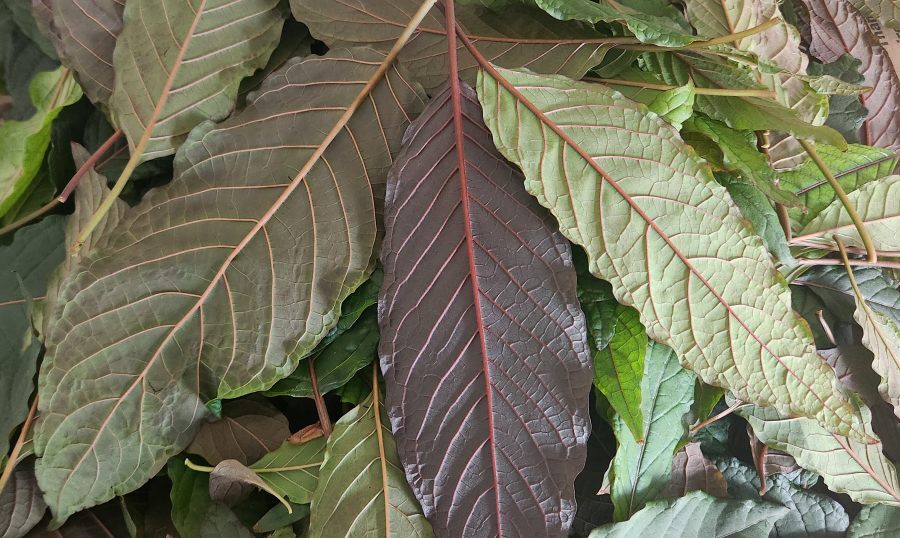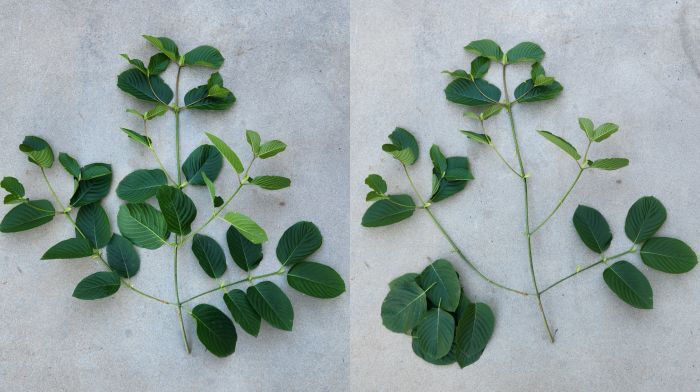The following guide covers every step—from harvesting the leaves, to curing and storage—based on the latest plant science and grower experience. Leaf maturity plays a key role in both alkaloid content and effect profile. Studies show that young to mid-aged leaves (around 15–45 days post-expansion) tend to contain the highest concentrations of mitragynine—the alkaloid most linked to kratom’s energizing qualities (Horizon Publishing 2023; Frontiers in Plant Science 2025). However, while older leaves typically contain reduced amounts of mitragynine, they tend to produce a calmer, more sedative effect—closer to traditional red-vein kratom—due to gradual shifts in alkaloid ratios. Both young and mature leaves have distinct chemical profiles and thus warrant exploration. For plant health, harvest below the youngest two leaf pairs, leaving the top growth to support photosynthesis. Leaves around the 3rd–5th node are typically mature, potent, and ideal for harvest. Below is a good before and after picture depicting which leaves are left behind to continue growing. After picking, rinse the leaves thoroughly in cool water to remove dust or debris. Swish them gently in a clean basin and drain immediately. Cleaning the leaves also helps them to dry more evenly and resist microbial growth during sweating or curing. Fresh kratom can be used right off the tree. Traditionally, growers chew the leaves (after removing veins) or brew them into tea. To make tea, they chop or tear the leaves and simmer in water with a splash of lemon or lime juice to enhance alkaloid extraction. This step can enhance aroma and subtly shift alkaloid ratios prior to fully drying. Some growers also briefly expose the leaves to sunlight or UV to develop even deeper coloration or “red-vein” effects (Frontiers 2025). Warning: Before attempting to sweat or cure any herbs, it’s essential to understand the process thoroughly to prevent unwanted microbial growth. There are many valid methods for sweating and curing kratom depending on one’s environment. The following is a broad explanation of common practices. Sweating is the process of keeping freshly harvested plant material in a warm, humid, semi-enclosed environment to encourage enzymatic activity and mild fermentation. For kratom, growers often aim for 65–75% relative humidity and 80–95°F for 12–36 hours. 1. Partially dry the leaves. This can be done in either shade or sun. The leaves should remain pliable but feel noticeably drier—similar to the texture of cured tobacco. 2. Place the leaves in a breathable enclosure. A cotton pillowcase or burlap sack is commonly used, as these materials allow airflow while still creating a contained environment. Plastic containers are not recommended. 3. Move the filled enclosure to a warm location where the internal temperature can remain consistently between 80 and 95°F. 4. Stir the leaves several times per day to release any built-up moisture and eliminate stagnant air pockets while also monitoring humidity closely. 5. After the desired duration, remove the leaves and fully dry them or move on to a curing stage. Curing is similar to sweating but is done at lower humidity and temperature for a longer period. This promotes slow oxidative changes rather than enzymatic ones. For curing, semi-dried leaves are placed in a sealed, non-reactive container—commonly glass—and kept at room temperature with a relative humidity of 55–65% for an extended time. Kratom cured this way becomes largely shelf-stable and can remain stored for months or even years, though it will continue to change gradually throughout the curing period. Drying helps lock in the desired alkaloid profile and preserves the harvest for later use. Prior to drying, one can allow the leaves to wilt post harvest for around 12 hours to increase mitragynine levels (Frontiers 2025). When drying, use shade or low-temperatures (below 40 °C / 104 °F).This preserves delicate alkaloids and prevents their degradation/transformation. Sun drying works too, but often deepens coloration and shifts chemistry toward a red-vein profile. In high humidity enviorments it may be necessary to artificially impliment air flow with fans or to use some sort of drying device like a food dehydrator. Spread leaves in a single layer with good airflow and turn them occasionally until crisp and evenly dried. Once dried, leaves are typically crushed or powdered: Removing the central vein is most common as its easier to process into powder and results in higher quality. Some choose to save vein material separately to use by itself or in a custom mix to moderate effects. Mixing leaves from different harvest stages, drying methods, or different chemotypes can yield custom profiles—from bright and stimulating to deep and relaxing. Keep notes on each batch so you can recreate your favorites. Store well dried kratom in an airtight container, kept cool, dark, and dry. Avoid sunlight and moisture, which can alter alkaloids. Vacuum-sealed jars or mylar bags help to extend shelf life and preserve freshness. Grower Tip: Keep a harvest log. Note leaf age, drying temperature, and curing method to fine-tune your results over time.How to Harvest Kratom Plants

1 – Harvesting Kratom Leaves

2 – Washing the Leaves
3 – Using Fresh Kratom
4 – Sweating (and/or) Curing (Optional)
5 – Drying
6 – Post-Drying Processing
7 – Mixing Kratom “Strains”
8 – Storage
⚠️ Common Mistakes When Harvesting Kratom
